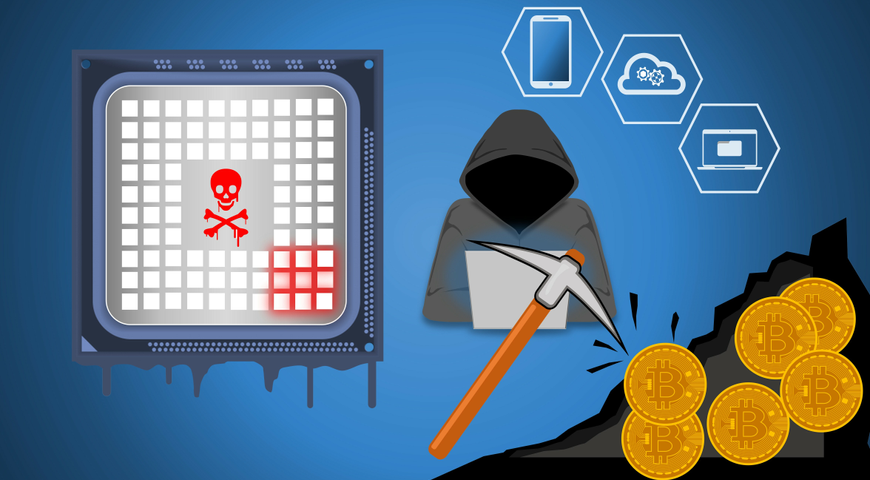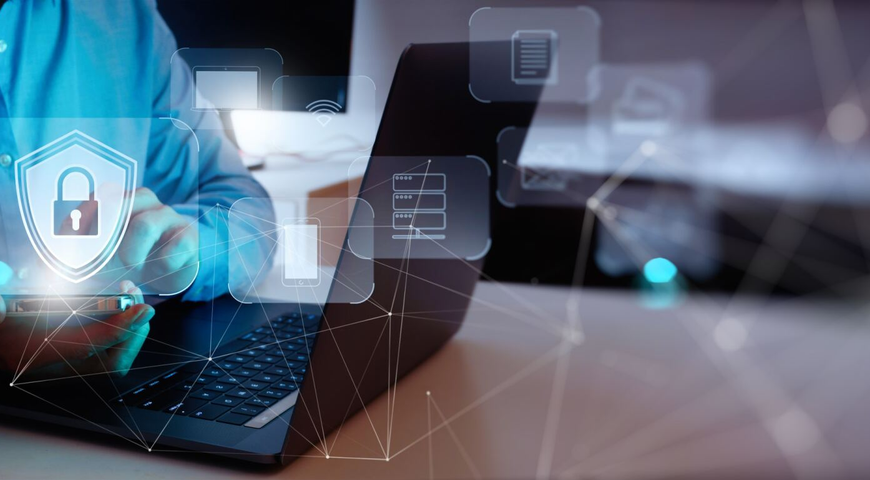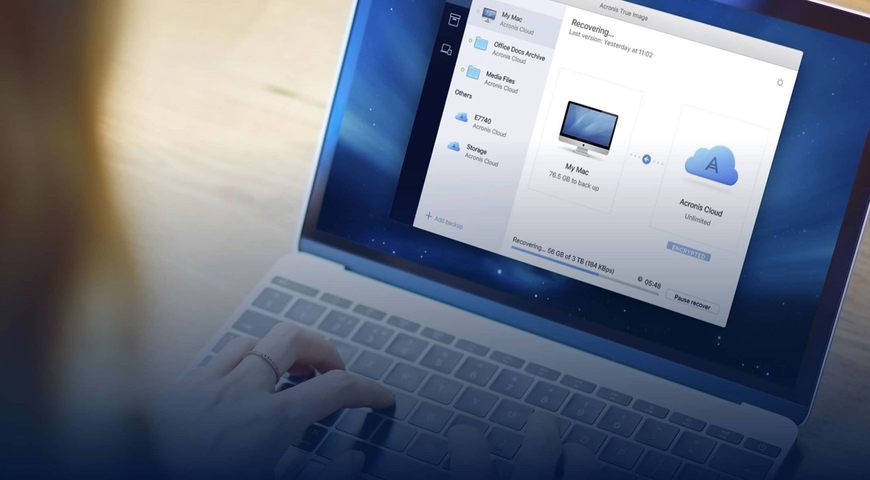
Cryptocurrency malware takes control of a victim's computer for cryptocurrency mining without detection. The pressing concern remains: how can one detect cryptojacking without allowing cybercriminals to exploit your resources? Several steps and tips can be employed to safeguard oneself but it unequivocally begins with being aware.
To see the whole picture of cryptomining malware, we must understand how cryptomining works and what the processes are. Cryptomining is performed by sophisticated hardware that solves an extremely complex computational math problem. The more math problems the computer solves, the more cryptocurrency will be rewarded as a prize for completing the current task.
The process of solving a math problem is time-consuming and demands a considerable amount of computer processing power and energy. As a result cryptomining becomes an impractical task for the average user. Nevertheless, when it comes to making money individuals will always strive to find more efficient and cost-effective methods in this pursuit. On the other hand, cybercriminals have turned to using cryptographic malware as a way of getting rich by committing cybercrimes.
What is cryptocurrency malware?
Cryptocurrency malware, also known as cryptojacking is a type of software that clandestinely harnesses your computer or mobile devices for cryptocurrency mining purposes. The user remains unaware and unauthorized of this instructive activity. This malicious software surreptitiously utilizes the victims' computing power and resources to fulfill its own financial objective resulting in depleting computer performance and escalated electricity costs for the unfortunate target.
Definition of malware, and how is it related with bitcoin mining?
Malware, short for malicious software is using a malicious code, which refers to any instructive software developed by cybercriminals to steal sensitive data and damage or destroy computers and computer systems. Types of malware include viruses, worms, Trojan viruses, spyware and ransomware. All these mean malicious code attacks have very serious consequences for their victims.
When cryptocurrencies were created and presented to the world, hackers saw these digital assets as a golden mine where they could attack and gain huge profits, and of course, their leads cannot be tracked.
What is bitcoin mining?
Bitcoin mining is the process of validating the information in a blockchain block by generating a cryptographic solution that matches specific criteria. When a correct solution is reached, a reward in the form of bitcoin fees for the work done is given to the miner who reached the solution first. As we said earlier, solving a math problem requires a lot of computing resources, and these resources consume a lot of electricity.
For that reason, hackers need as many cryptojacked computer systems as possible, and they obtain that working power by infecting computers with cryptocurrency malware. Like any other malicious attack, the main motive is profit, but unlike other threats, it is designed to remain hidden from the user.
How does cryptocurrency malware work?
As we said above, cryptomining malware is as destructive for the victims as all other types of malware. The goal of these attacks is to generate profits and take advantage of the users devices by using their resources, and then leave the bills to be paid by their victims.
It is a heavy and slow process requiring just enough system resources to solve the puzzles, while doing so, the processors are constantly running at maximum capacity, and of course they need more electricity, which leads to higher bills for the computer owners and decreases the life of the victim's device rapidly.
Early instances of malicious versions of drive-by cryptomining don't bother asking for permission and keep running long after you leave the initial site. This is a common method for owners of dubious sites that have compromised legitimate sites. Furthermore, users have no idea that the site they have visited uses their computer to mine cryptocurrency.
Another mean way of gaining profits was revealed by Ars Technica in January 2018 that Youtube advertisements contained Javascript code that mined the cryptocurrency Monero, by the time you are watching video advertisements, the harmful software uses your devices, resources without the victim's knowledge.
Another malware practice is while a user is playing games for free on, say, a gaming site. The Javascript code mines coins, by doing so, hackers are using the web traffic to gain a large amount of profit, and they have posed it as a fair exchange, where you get free games to play while they use your computer or mobile device for mining.
Types of cryptocurrency malware
CryptoLocker is a Cryptojacking malware that holds your files in ransom by encrypting them, we can say confidently that this is a type of crypto ransomware. Encryption is based on two "keys" — one public key and one private key. Cryptocriminals use the public key to encrypt and lock your files, they also hold the private key to decrypt them, of course, in case the victim has paid the ransom.
Prometei Botnets are networks of computers infected with Cryptojacking malware and controlled as a group without the victim's knowledge. Prometei Botnets' aim is to install itself on as many devices as possible in order to mine the cryptocurrency Monero. This type of malware targets victims randomly and uses known exploits to spread itself across a network of devices and execute cryptomining attacks.
PowerGhost is a fileless cryptomalware that attacks corporate servers and spreads itself undetected across the servers, making it incredibly harmful. Furthermore, it has the capability of disabling antivirus software with the purpose of evading detection and stealing as much cryptocurrency as possible from the victim's digital wallet.
Cryptojacking scripts and malware
Cryptojacking is a cybercrime also known as malicious cryptomining scripts. It is an online threat that hides on a computer or mobile device and uses the machine's hardware resources to mine cryptocurrency without paying for electricity and other mining resources. Getting infected with this type of malware requires just one click on a malicious link in an email or website, and it loads cryptomining code directly on the computer or mobile device.
Malicious cryptominers strike through web browser downloads or rogue mobile device apps. Where drive-by cryptominning can infect your Android mobile device. Cryptojacking compromises all kinds of devices like laptops, desktop PCs, smartphones, and network servers, this means that nobody is protected from this type of cryptojacking software. The motive of cryptojacking code and malicious attacks is to generate profits, but unlike many other threats, they are made to stay completely hidden from the victims.
Trojan malware
Trojan malware can cause enormous problems and consequences for the infected devices. Once the infection is into your system, it can install other malware software and cause a variety of other problems that can be destructive for the software and hardware of any device.
Trojan viruses have the ability to steal your personal information, furthermore, they put you at risk for identity theft and other cybercrimes. Some trojans download additional malware software on your computer and then bypass the antivirus and security settings, leaving them in a position to make whatever they want with your devices, which can be extremely destructive and harmful.
Trojans also have the ability to hijack your computer system and make it part of a criminal DDoS network. Another disturbing fact about the trojan malware is having the ability to get through open windows. Although, the user thinks the visible browser windows are closed, a hidden one stays open. Usually it is a persistent pop-under which is sized to fit under the task bar, making it very hard to be noticed.
Ransomware
Ransomware is a type of that has the purpose of preventing or limiting users from accessing their files or entire systems. This is accomplished by locking the victims' files until a ransom is paid.
Cybercriminals employ this tactic to compel users to pay the ransom using specific online payment methods, such as cryptocurrencies in order to obtain the decryption key. If users fail to pay promptly their data will be lost permanently, or the ransom amount will increase rapidly.
Unfortunately, these kind of attacks are very common and numerous major companies in Europe and North America have fallen into the nets of the cybercriminals. Even if users pay the ransom to restore access to their data, they are likely to encounter further ransomware attacks, until the malicious software is completely removed from their system.
Impact of cryptomining malware
As we know, cryptocurrency malware does not steal or lock your data, so it may not be regarded as a significant cyberthreat compared to a costly ransomware attack or disruptive Trojan virus. Nonetheless, its ongoing use of users' computing resources to mine cryptocurrencies and valuable coins is draining and significantly impacts the productivity of the hijacked devices.
One of the main symptoms of being infected with cryptocurrency malware is slower computer performance, which results in the inability to perform multiple tasks simultaneously. On the other hand, the user will experience higher electricity bills because of the constant work on the maximum capacity of his computer.
Negative impact on computer performance caused by cryptocurrency mining
Depending on each case, the impact of cryptocurrency malware can be different. Still, the most typical consequences noticed by the victims are:
- Lack of performance of the system due to the usage of CPU (central processing unit) and bandwidth resources by illegal cryptomining activity
- Disruptions of routine operations
- Financial losses due to increased power consumption and the downtime caused by cryptojacking activity and the constant work of computing power
- Additionally, there can be a cost associated with recovering files and systems
- Reputational and compliance risks and unauthorized access to the system
Increased risk of identity theft
Cryptocurrency malware uses the same methods as ordinary malware, and as we know, when a computer is infected with malware, there is always a huge risk of identity theft due to the distributed database and the complete access by the cyberattackers.
The infection can be implemented on your computer or mobile device by opening a malicious link, visiting an infected site, or downloading an app that gives the attackers the ability to access their victims data.
How to protect yourself from cryptocurrency malware?
Everybody should be concerned about being infected with this dangerous malware type and should consider using a cryptojacking blocker on their devices. Furthermore, there are some malware precautions that can be used to prevent a cryptojacking attack and other malicious software. While most crypto hacks involve stealing private keys that belong to users cryptocurrency wallets, their purpose is to empty them and generate financial profits.
In the end, the whole cryptojacking code and work process is not much different from the rest of the types of malware. The Cybersecurity and Infrastructure Security Agency (CISA) published a list of tips to follow for protecting your devices with technical details, but here are the basics and that are easier to execute to avoid online threats and getting infected by cryptocurrency malware.
Use ad blockers in your browser to prevent browser mining.
- Install security programs such as antivirus and malware active protection and keep them up to date
- Avoid visiting websites that are known for running cryptojacking scripts
- Disable Javascript in your browser
- Protect server parks with cybersecurity systems
If you follow these easy to execute tips, you will minimize the chance of becoming a victim of cryptocurrency malware.
Keep systems and software up to date
Another key aspect of protecting your devices in the best possible way is keeping your antivirus and malware software up to date, thus, you will rapidly increase your security walls. By doing so, it will be a lot harder for cybercriminals to slip through your protection systems. As with all other malware precautions, it's much better to install security and keep it up to date before you become a victim.
Use anti-virus software
One of the most important things you can do to protect yourself from all kinds of malicious attacks and any harmful software is to install antivirus software on every device you have. Let me explain it with very simple words, if you have antivirus software, you are protected, if not , you are a sweet bite for the cybercriminals.
Through the years, all kinds of cyber threats have constantly upgraded and become more dangerous than ever. Luckily, computer antivirus softwares, including comprehensive cybersecurity programs, do the same, by upgrading techniques and methods to protect your devices, they are capable of ensuring a safe environment for every single one of them, so having such software is lifesaving!
Be cautious of suspicious emails and links
Malware and all the variety of cyberthreats are waiting behind the corner to strike at the right moment. They are using well covered mean techniques to catch victims in their traps through visible browser windows, malicious links, infected files, and many other ways.
The most common trap they set up is providing suspicious emails and links. Afterwards, they just wait to catch as many victims as possible. Furthermore, the problems and performance issues become hard to control by the users. And at the end of the day, you can lose important data, being blackmailed for money or cryptocurrency, and have many other serious consequences for you and your devices.
Another revenue model that has become very popular among cybercriminals is placing a few lines of JavaScript into their web pages so as to enlist their visitors CPU power to mine cryptocurrency directly from the browser by infecting these websites with coinhive's code for their financial goals. This kind of cyberattack can be easily stopped by just closing the browser tab, which will terminate all the processes using your device's resources.
Use complex passwords and two-factor authentication
For the last decade, the security features have improved rapidly with constant updates and implementation of new features to provide better security. One of the most useful upgrades is two-factor authentication, which represents a security system that requires two separate and distinct forms of identification in order to access user accounts.
The first and main factor is a password, and the second includes text with a code that is sent to your devices. Another very useful factor is using biometrics like fingerprint recognition, face recognition, or retina recognition, these are the hardest factors to hack, and they ensure the best security for your accounts.
Experts advise that if we use only a password without two factor authentication, we should make our password as complex as possible. It is mandatory to have at least 18 characters in your password, including letters (both uppercase and lowercase), numbers, and symbols, without including any obvious personal information or common words. By doing so, you will ensure the best protection for your accounts.
Conclusion: The importance of being vigilant against cryptocurrency malware
As we explained above, a cryptojacking attack, bitcoin mining, or any other cryptocurrency mining, will affect the performance of users' phones, computers and Iot devices. Users' main responsibility is being vigilant about the disturbing and noticeable effects of using their device resources without their knowledge.
As we said, the most obvious symptom of having cryptocurrency malware is decreased performance on computing devices. You should also watch for slower system performance, and the last one is when your battery is draining faster than it usually would.
Anti-malware software against cryptocurrency scams (Acronis Cyber Protect)
At the end of the day, everybody wants to have the best anti-malware software to keep them protected from cryptocurrency scams. And we have the best offer for our customers to feel safeguarded about their digital assets, where Acronis Cyber Protect Home Office takes responsibility for guaranteeing the safety of our clients.
Within our company, we boast a remarkable offer that allows customers to feel genuinely protected in terms of their digital assets and cryptocurrencies. This is a privilege made possible through Acronis Cyber Protect unwavering commitment to guaranteeing our clients' safety. Through incessant updates and upgrades we have craved a niche for ourselves as industry leaders, diligently providing unparalleled antivirus and anti-malware software.
Acronis Cyber Protect Home Office offers an extensive range of cybersecurity services that persuasively positions our product as the ultimate choice, that you can make. Opting for our software ensures receiving the best protection against a multitude of malicious threats and malevolent software that lurk, eagerly awaiting moment of vulnerability. If you are looking for the best security software, then you have already found it. Don't hesitate to ensure the best cyber protection for your devices, by choosing Acronis Cyber Protect Home Office.
About Acronis
A Swiss company founded in Singapore in 2003, Acronis has 15 offices worldwide and employees in 50+ countries. Acronis Cyber Protect Cloud is available in 26 languages in 150 countries and is used by over 20,000 service providers to protect over 750,000 businesses.




